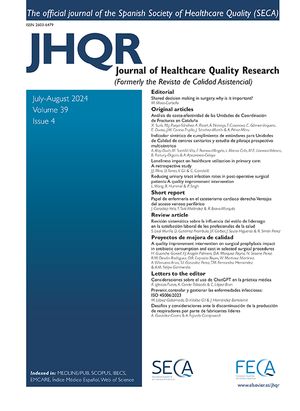El Conjunto Mínimo Básico de Datos (CMBD) se ha utilizado para estimar la complejidad de los pacientes y elaborar indicadores de calidad, no obstante, se han descrito problemas de calidad y exhaustividad en el mismo. El objetivo de este estudio es evaluar la calidad del registro de infecciones postoperatorias en el CMBD en un hospital de tercer nivel y analizar las variables relacionadas.
MétodosSe diseñó un estudio observacional retrospectivo, en el que se comparó la información disponible sobre infección postoperatoria en el CMBD con la de la base de datos del sistema de vigilancia activa del Servicio de Medicina Preventiva, que se consideró sistema de referencia (gold standard). Se incluyeron todos los episodios de hospitalización en los que el Servicio de Medicina Preventiva encontró una infección postoperatoria. Las infecciones se clasificaron en Infección Superficial de la Herida (ISH), Infección Profunda de la Herida (IPH) e Infección de Órgano/Espacio (IOE). Los criterios diagnósticos utilizados fueron los establecidos por los Centers for Disease Control.
Por medio de un modelo de regresión logística, se analizó la asociación entre variables relacionadas con el paciente y el episodio de ingreso, y el registro o no de la infección postoperatoria en el CMBD.
ResultadosEl sistema de vigilancia registró 300 casos de infección postoperatoria, con una incidencia acumulada anual de 2,8%. De ellas 219 correspondían a IHS, 27 a IPH y 54 a IOE. En 172 casos (57,3%) no aparece el código de “infeción postoperatoria” en el CMBD. Esta proporción es el 57,5% en la ISH, el 44,4% en la IPH y el 63% en las IOE. En el modelo de regresión logística incluimos el servicio que da el alta y el tipo de infección.
ConclusionesExiste un importante subrregistro en el CMBD de las complicaciones infecciosas asociadas a la cirugía. No encontramos ninguna variable claramente relacionada con el registro de la infección postoperatoria. El diseño de estrategias de intervención nos llevarían a mejorar la calidad de los informes médicos y el correcto registro de las complicaciones infecciosas. Estas estrategias deberían estar dirigidas a los servicios con mayor margen de mejora en el índice de case-mix y peor calidad de información clínica recogida en el CMBD.
The Minimum Basic Data Set (MBDS) has been used to assess the complexity of patients and create quality indicators, although there is concern about problems of quality and exhaustivity. The aim of this study is to assess the quality of the register of postoperative infections in the MBDS in a third level hospital and to analyse the variables related with it.
MethodsA retrospective observational study was carried out, in which the available information about postoperative infections in the MBDS was compared with the infection active surveillance system of the Preventive Medicine Service data base, that was considered reference system (gold standard). We included all the hospitalization episodes in which the Preventive Medicine Service found postoperative infection. The infections were classified in Superficial Incisional Surgical Site Infection (SISSI), Deep Incisional Surgical Site Infection (DISSI) and Organ/Space Surgical Site Infection (OSSSI). The diagnosis criteria were those from the Centers for Disease Control.
By means of a logistic regression model, we analyzed the association between variables related to the patient and the episode, and the diagnosis of postoperative infection in the MBDS.
ResultsThe surveillance system registered 300 cases of postoperative infection, with an annual accumulated incidence of 2.8%. Among them 219 were SISSI, 27 DISSI and 54 OSSSI. In 172 cases (57,3%) the postoperative infection code was missing in the MBDS. This proportion was of 57,5% in the SISSI, 44,4% in the DISSI and 63% in the OSSSI. In the logistic regression model we only included the discharge Service and the infection type.
ConclusionsThere is an important underregister of infectious complications associated with surgery. We didn’t found any variables clearly related with the correct register of the postoperative infection. Intervention strategies should be conducted to improve the quality of the medical records and the correct register of infectious complications, targetted to the the services with higher case-mix index and worse quality of clinical information in the MBDS.






